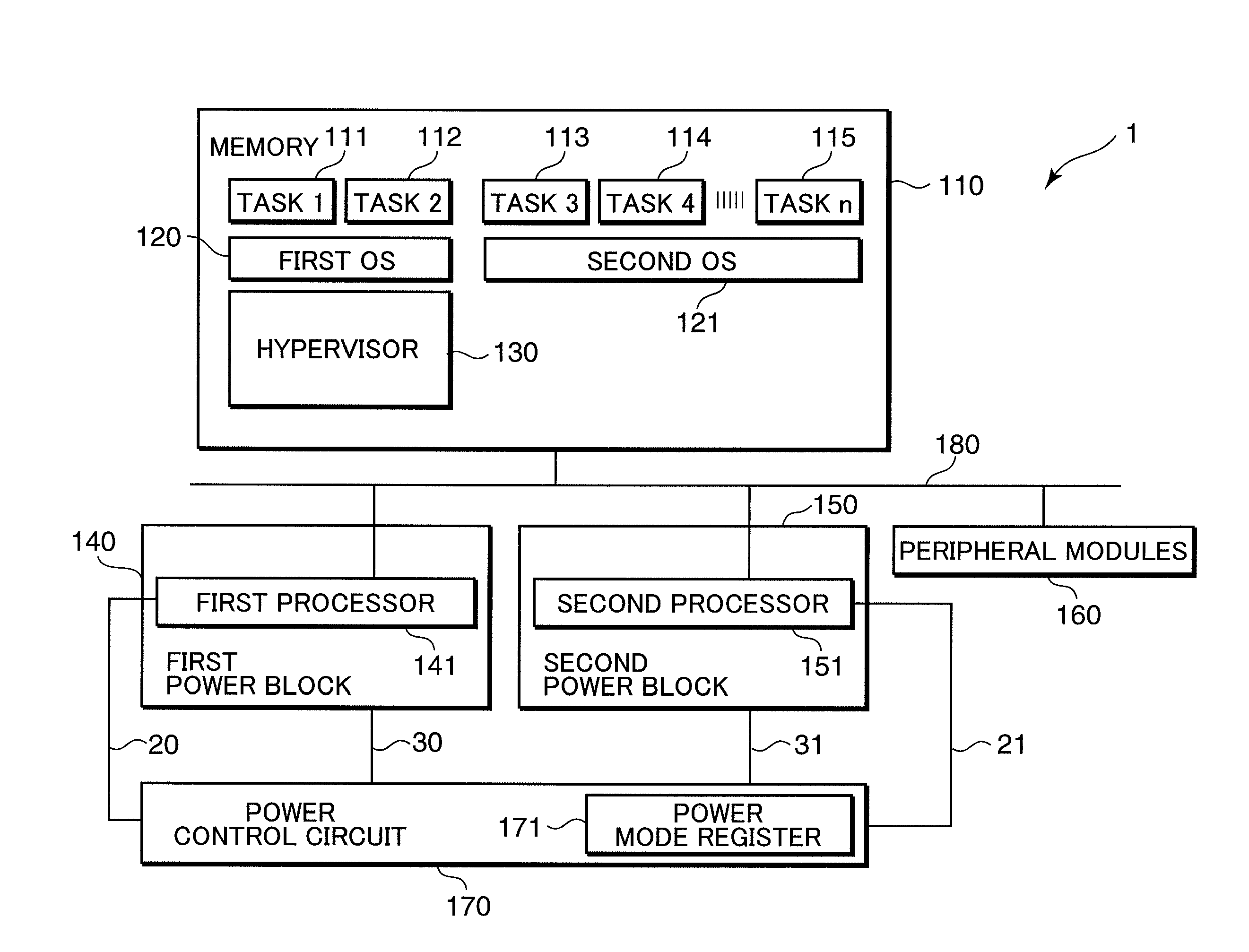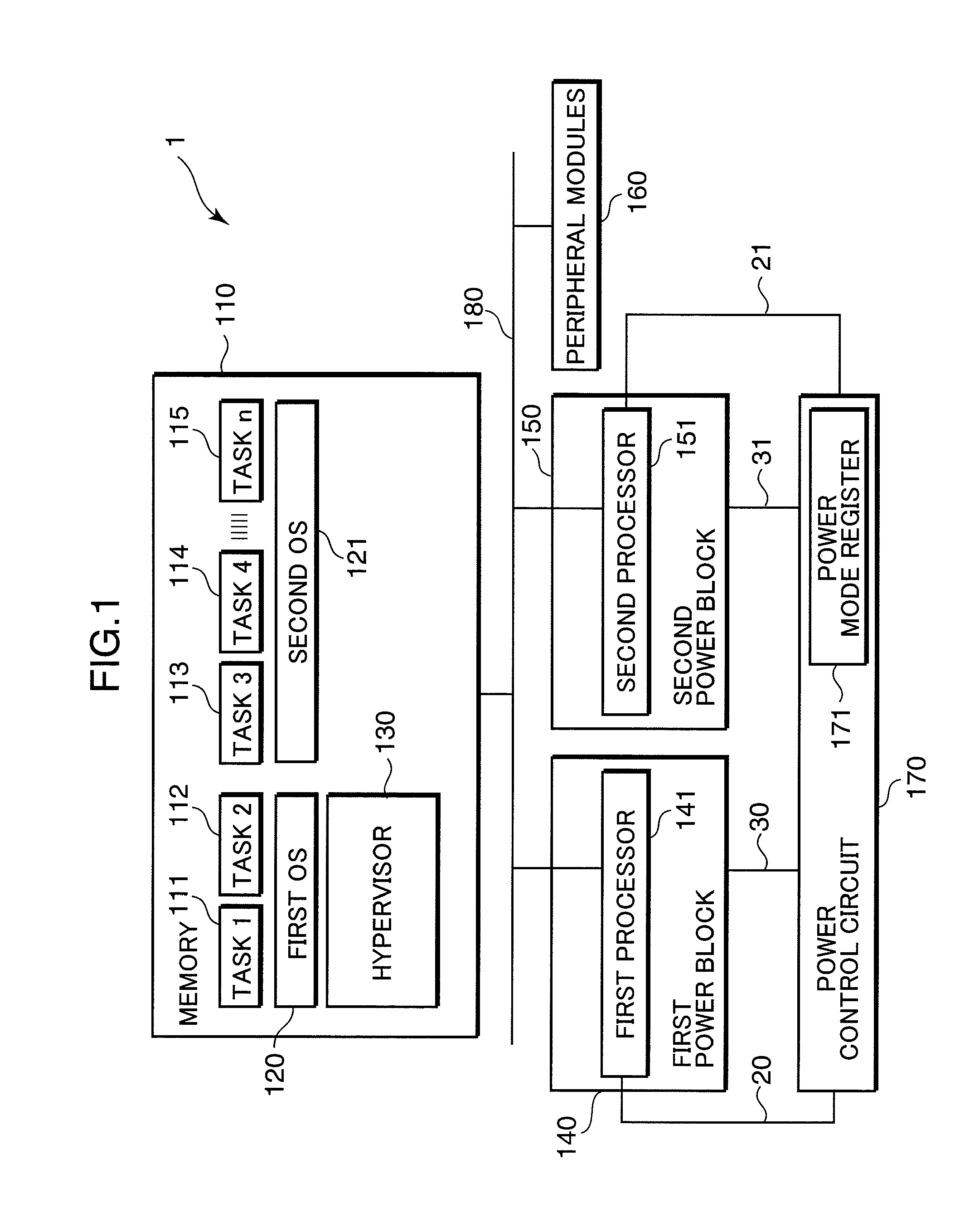Multiprocessor control apparatus, multiprocessor control method, and multiprocessor control circuit
a control apparatus and control circuit technology, applied in the direction of memory adressing/allocation/relocation, multi-programming arrangements, high-level techniques, etc., can solve the problems of increasing overhead, increasing the required electric power consumption to some extent, and it is difficult to apply a low-power consumption processor architecture to only a processor. achieve the effect of reducing electric power consumption
- Summary
- Abstract
- Description
- Claims
- Application Information
AI Technical Summary
Benefits of technology
Problems solved by technology
Method used
Image
Examples
first embodiment
[0043]FIG. 1 is a diagram showing an example of a concrete configuration of a multiprocessor control apparatus (hereinafter, called as a multiprocessor system) in the first embodiment of the invention.
[0044]Referring to FIG. 1, the multiprocessor system 1 in this embodiment includes an internal bus 180, a memory 110 to be connected to the internal bus 180, a first processor 141 which executes an instruction code stored in the memory 110, a second processor 151 which executes an instruction code stored in the memory 110, a power control circuit 170, and peripheral modules 160 to be connected to the internal bus 180.
[0045]In this embodiment, the first processor 141 is a processor (hereinafter, called as a “low-power consumption processor”) having a lower performance and a smaller electric power consumption than those of the second processor 151. The second processor 151 is a processor (hereinafter, called as a “high-performance processor”) having a higher performance and a larger elec...
second embodiment
[0115]FIG. 7 is a diagram showing an example of a configuration of a multiprocessor system in the second embodiment. Referring to FIG. 7, constituent elements having the same reference numerals as those in FIGS. 1 and 6 are constituent elements substantially identical or equivalent to those in FIGS. 1 and 6, and detailed description thereof is omitted herein.
[0116]Referring to FIG. 7, the multiprocessor system 3 in the second embodiment includes an internal bus 180, a memory 110, a first processor 141, a first cache memory 142, a second processor 151, a second cache memory 152, a power control circuit 170, and peripheral modules 160.
[0117]The multiprocessor system 3 in this embodiment has a feature that the power control circuit 170 is configured to control electric power supply to each of the low-power consumption processor 141, the high-performance processor 151, the first cache memory 142, and the second cache memory 152.
[0118]In the second embodiment shown in FIG. 7, the power b...
third embodiment
[0153]In the foregoing embodiments of the invention, the low electric power consumption technology mainly using processors has been described. Generally, however, it is necessary to realize the low electric power consumption technology including a memory and peripheral modules. For instance, in an ordinary multiprocessor system and multi-core LSI, normally, peripheral modules are correlated to individual processors by one-to-one correspondence in terms of hardware or at initialization; or notify a result such as an interruption to a processor which has conducted a process request.
[0154]However, in the foregoing embodiments, if there is a correlation between a processor and peripheral modules which perform e.g. an interruption, an unintended processor may be operated at a timing such as an interruption, which may fail to realize an intended low electric power consumption technology.
[0155]As described above, in the conventional multiprocessor system, it is often the case that individu...
PUM
 Login to View More
Login to View More Abstract
Description
Claims
Application Information
 Login to View More
Login to View More - R&D
- Intellectual Property
- Life Sciences
- Materials
- Tech Scout
- Unparalleled Data Quality
- Higher Quality Content
- 60% Fewer Hallucinations
Browse by: Latest US Patents, China's latest patents, Technical Efficacy Thesaurus, Application Domain, Technology Topic, Popular Technical Reports.
© 2025 PatSnap. All rights reserved.Legal|Privacy policy|Modern Slavery Act Transparency Statement|Sitemap|About US| Contact US: help@patsnap.com



